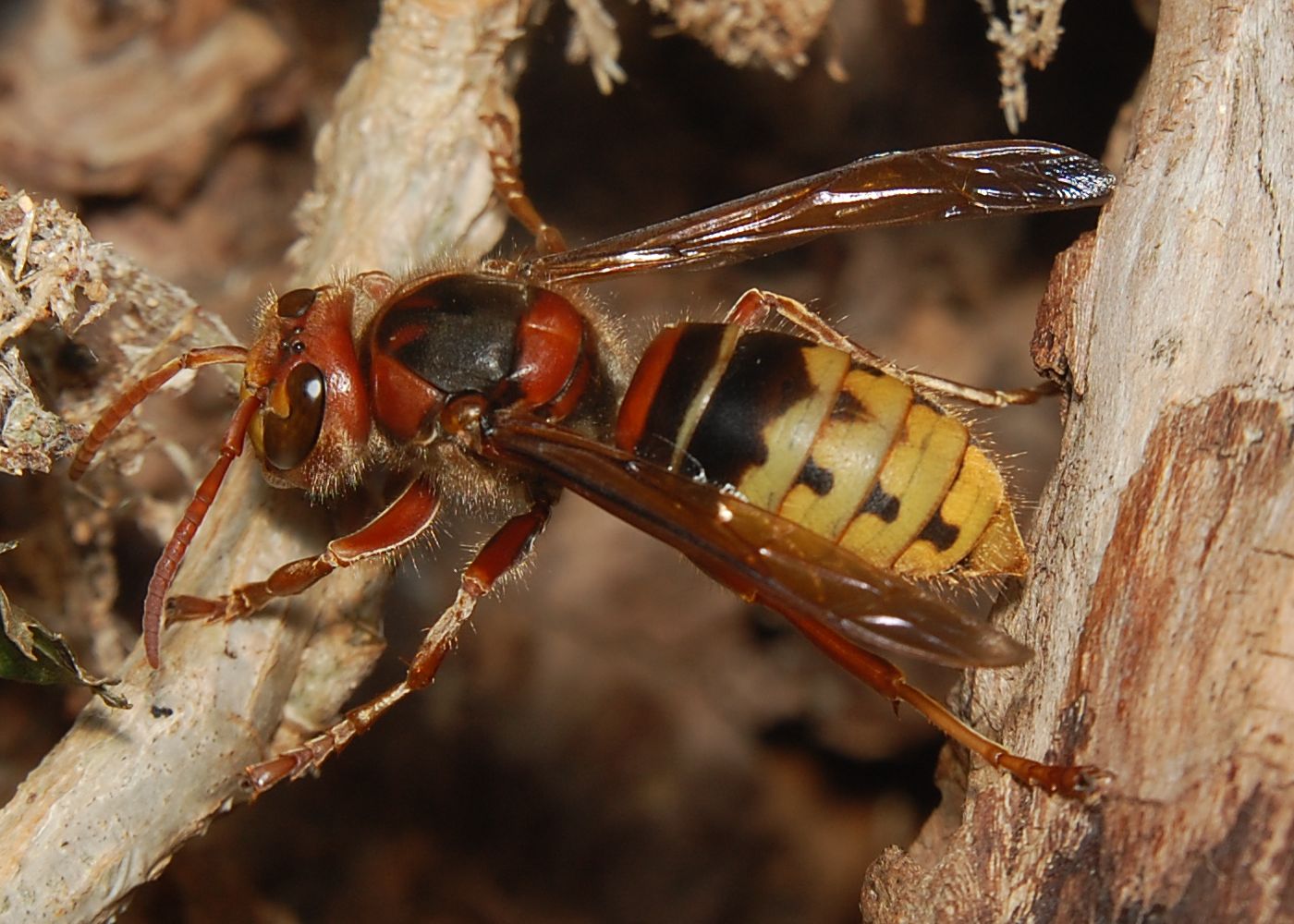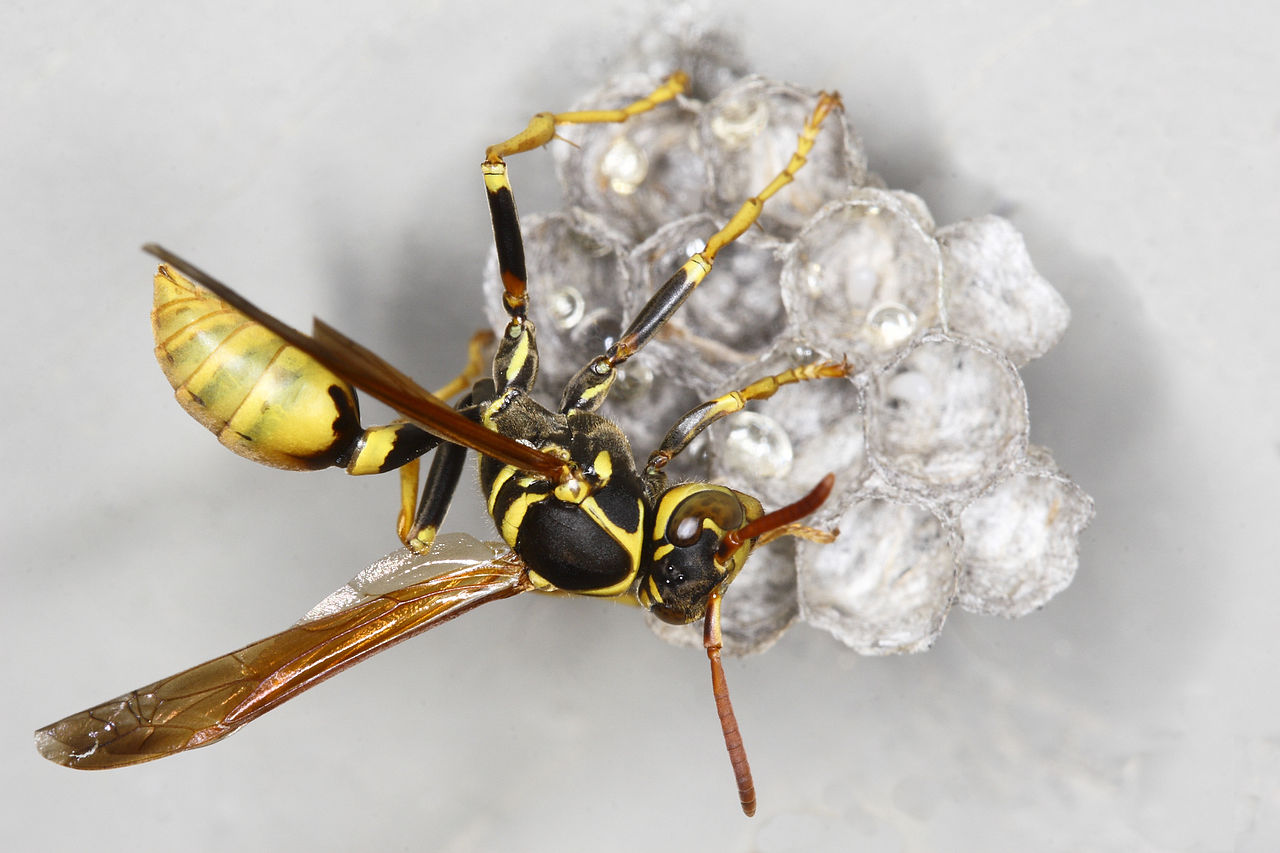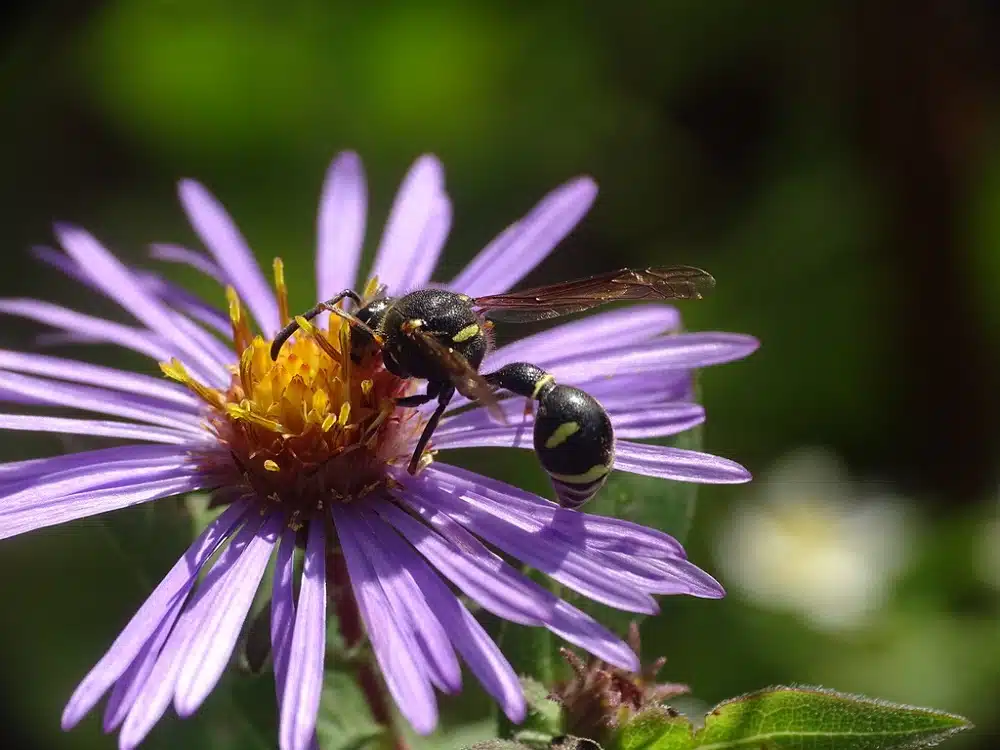Black and yellow wasps are the most common wasps you will encounter.
They are flying insects and you can tell them apart from bees with their slender bodies and transparent wings.
Black and yellow wasps also have slender waists and are common in the United States. Continue reading below to help you identify the black and yellow wasps you are likely to encounter in the US.
Table of Contents
1. European Paper Wasp
The European Paper Wasp (Polistes dominula) is the most common black and yellow wasp you will encounter. It is a social wasp with a diverse diet. Dominant females are the egg layers with subordinate females being the workers.
There is very little variation among individuals with males having a wingspan of 13mm and females having a wingspan of 12mm. The body is made up of black and yellow bands.

2. Eastern Yellowjacket

Eastern Yellowjackets (Vespula maculifrons) are common in eastern North America and are often seen nesting in buildings and recreational areas. They are social wasps, living in colonies that comprise hundreds of individuals. They will aggressively defend their hive against any threats.
These wasps have black and yellow lines on their abdomen, head, and thorax. They can grow to 16mm in body length and weigh approximately 0.04g. Queens are the largest, followed by males, and then workers.
Nests accommodate thousands of workers with large nests having up to 15,000 cells. Nests are red-orange to tan-brown. They are constructed of decaying wood that is fragile.
3. Yellow-legged Mud-dauber Wasp

The Yellow-legged Mud-dauber Wasp (Sceliphron caementarium) is also known as the black and yellow mud dauber inside the United States. This wasp can grow to 28mm in length. They have a black petiole and the thorax has yellow markings. The abdomen is black. Females have yellow on the abdomen.
They have black eyes and antennae with yellow legs. They are the only wasp species with yellow on their legs in the United States.
4. Eastern Cicada-killer Wasp

This wasp (Sphecius speciosus) is often referred to as the cicada hawk or the cicada killer. It is a large solitary wasp that preys on cicadas in North America. They are commonly encountered in the eastern and Midwest United States, Central America, and Mexico.
These wasps can grow to 5cm in length. They are robust, hairy, and have black on their thorax. The abdominal section is marked with light yellow stripes. Their wings are brown. They resemble hornets and yellowjackets.
Females are larger than males and are considered the largest wasps found in the eastern United States.
5. Western Yellowjacket

The Western Yellowjacket (Vespula pensylvanica) is native to North America, especially in temperate areas. Populations are known to explode in warm weather. They have become invasive in the Hawaiian Islands and are considered a serious pest.
This wasp shares the same yellow and black pattern as other species and is often misidentified. The identifying factor is that this wasp has a continuous yellow ring around each eye. They also have a spotted mark just below the antennae.
They can have a wing length of 10.5mm in workers, 14.5mm in females, and 14mm in males. They construct large nests made of wood fibers with a small entrance located at the base. The nests are found below the ground, often in rodent burrows.
6. European Hornet

European Hornets (Vespa crabro) are the largest eusocial wasps. They are native to Europe and are the only true hornet found in North America. They were introduced to the United States in the early 1940s.
This wasp avoids conflict but they will sting if you accidentally step on them or grab them. They are defensive of their nests and tend to be aggressive near food sources. This carnivorous wasp feeds on other wasps, moths, beetles, mantises, and dragonflies. They will also feed on fallen fruits.
They have red-orange wings, a yellow and brown striped abdomen, and a hairy thorax. They grow to approximately 25mm in length with the queens growing to 35mm. Females are larger than males in mass and size.
Males have seven abdominal segments, whereas females have six. Only the females have a stinger. Males have longer antennae comprising thirteen segments, whereas females have twelve antennae segments.
7. Common Aerial Yellowjacket

The Common Aerial Yellowjacket (Dolichovespula arenaria), also known as the common yellow hornet or sandhills hornet, is distributed throughout North America. These yellow wasps lack black markings in the ocular sinus.
Queens have large black spots on the 4th and 5th terga with smaller spots on the 2nd and 3rd terga. Males have large antennae with spots on the basal band on the 4th and 5th terga.
8. German Yellowjacket

German Yellowjackets (Vespula germanica) are found throughout the Northern Hemisphere. They are native to Europe and have become well-established in South and North America. This wasp can grow to 13mm in length and weigh up to 9.6mg.
They are black and yellow with three black dots on the clypeus. They are not easily distinguished from other black and yellow wasps.
9. Hump-backed Beewolf

This black and yellow wasp (Philanthus gibbosus) is often called a beewolf due to its predation practices. It is a bee-hunting wasp and is common throughout North America. It is native to the Midwestern United States and is often seen visiting flowers and other plants, searching for prey.
This small and robust wasp can grow to 12mm in length. They have broad heads and shiny bodies with yellow spots on the head and yellow stripes on the thorax and abdomen. There are deep punctures on the abdomen.
Males are similar to females except they lack the yellow spots on the head.
10. Golden Paper Wasp

Golden Paper Wasps (Polistes aurifer) are found in the western parts of North America, southern Canada, and northern Mexico.
This species has different grading color patterns, depending on their geography. The northern species are mostly black with yellow markings and rusty red ferruginous. Those in the southwestern United States are completely yellow.
11. Hidalgo Mason Wasp

The Hidalgo Mason Wasp (Euodynerus hidalgo) is a large wasp that will grow to more than 9mm n length. They have black bodies with well-developed yellow markings. Some individuals have ivory or rusty-colored markings. Each mandible has a pale spot on the base. There is a pale spot present behind each eye.
Males have thirteen antennae segments, while females have twelve. The front margin of the pronotum has a raised ridge. A pale stripe can be seen on the rear of the body.
12. Noble Scoliid Wasp

The Noble Scoliid Wasp (Scolia nobilitata) is a large wasp with a stout body and bright patterns of white, red, and yellow. Often, they will have one of these colors with black. They are common in the United States
This wasp is predominantly black with two to three broken yellow bands on the abdomen. They have black transparent wings and short black antennae. Many have red on their heads and backs.
13. Bramble Mason Wasp

Bramble Mason Wasps (Ancistrocerus adiabatus) are small wasps with a smiley face on their thorax. This wasp belongs to the Vespidae family. This wasp lays a clay jug on plant stems for their eggs. The jugs are made using mud.
It is a solitary wasp and is found throughout North America. They grow to one-third of an inch with females being larger than males. They use preexisting holes for their nests, often a rock crevice, hollow stem, or man-made tunnels.
The larvae pupate in their cells with males emerging before the females. There have been reports that this species migrates in large swarms to find suitable prey. They have developed a migratory habit to keep up with their wandering prey.
14. Five-banded Thynnid Wasp

The Five-banded Thynnid Wasp (Myzinum quinquecinctum) is a medium-sized black and yellow wasp that is considered beneficial, as they feed on numerous beetles that are known to destroy flowers and trees. Only the females possess a stinger.
Males have brown wings, while females have orange wings. Females lay their eggs in beetle larvae, while it is buried under the ground. The beetles feed on the plant roots, leading to stress on young plants.
When the wasp larva hatches, they invade the beetle, eating it from the inside out, resulting in the beetle’s death.
15. Widow Yellowjacket

The Widow Yellowjacket (Vespula vidua) is commonly encountered in the United States from the Great Lakes to Minnesota, Missouri, North Dakota Iowa, to Georgia. They built their nests in wall structures.
The adults feed on nectar, while larvae feed on arthropods. It is a predatory wasp known to scavenge on freshly dead caterpillars. This wasp can grow to 15mm in length and is a robust wasp.
If you accidentally disturb their nest, the air fills with pheromones, attracting all the widow yellowjackets in the area. They are very aggressive when it comes to defending their nest.
16. Alaska Yellowjacket

The Alaska Yellowjacket (Vespula alascensis) is often called the common yellowjacket. It inhabits North America and was named in 1870. This species nests under the ground but it is not uncommon for them to sometimes built aerial nests, this could be due to the ground being too cold to support the nesting process.
They are social insects and live in large groups. They are defensive of their nests which can result in a painful sting. They will sting multiple times without losing their stinger. They increase in number at the end of summer as the nest disperses after rearing the young.
These wasps have black and yellow bodies with yellow legs. The abdomen has defined yellow markings and there are two lines on either side of the pronotum with a yellow line on the front half and front margins. There is a yellow eye ring just behind the eye.
17. Smiling Mason Wasp

The Smiling Mason Wasp (Ancistrocerus campestris) is a small stinging wasp that can be found throughout the United States. They are black and yellow with a narrow waist. Females can have an 11mm forewing length.
They have black heads with large compound eyes and three small simple eyes in a triangle on the top of the head. The thread-like antennae comprise thirteen segments with a long first segment.
The thorax is black and comprises three segments. The sidebands are the widest and narrow in the middle, often interrupted in the center. The mesothorax or front plate has no yellow and is completely black.
They have smoky brown wings with dark veins that fold longitudinally over the body when the wasp is resting. They have black legs with claws at the end of each tarsus. Males can have up to 9mm in forewing length with twelve antennae segments.
18. Western Paper Wasp

The Western Paper Wasp (Mischocyttarus flavitarsis) is found in western North America. Their nests can be encountered in forests, usually close to rivers or close to human habitats, including under the eaves of roofs.
They typically do not sting but rather ram themselves into any threats. They feed on nectar, animal carcasses, and arthropods, they trail their hind legs as they fly. They have thin and long bodies that are brown, black, and yellow.
You can identify their nests hanging about 3mm under a stem of a plant. They create small nests of around three hundred cells per colony.
19. Toltec Scoliid Wasp

This black and yellow wasp (Dielis tolteca) has four bands on the abdomen. Females have an orange abdomen. They are non-aggressive and spend their day sipping on nectar. Their brown translucent wings have dark veins.
This is a small wasp that is common in North America.
20. Lobed Mason Wasp

The Lobed Mason Wasp (Ancistrocerus antilope) belongs to the Vespidae family. They have shiny bodies with yellow spots on the scutellum. They are common throughout North America.
They have black bodies with yellow banding. The black thorax and head have yellow markings, along with the legs. They can grow to 0.8 inches in length and are known for nesting under the ground, often using old nests of the mud dauber.
21. Downy Yellowjacket

This black and yellow wasp (Vespula flavopilosa) can be a nuisance building large nests with thousands of wasps. They are known to scavenge food at picnics and outdoor events, especially when sugary foods and beverages are being served.
They have a chemical that is released into the air, signaling guard wasps to come and sing if they feel threatened. They are social wasps that live in a colony comprising workers, males, and queens. They are very protective of their nests.
They feed on fruits, flower nectar, and tree sap. Larvae, on the other hand, feed on insects, fish, and meats.
22. Large Four-spotted Scoliid Wasp

The Large Four-spotted Scoliid Wasp (Pygodasis quadrimaculata) belongs to the beetle hunter family. They are large and hairy. This is a solitary species. Females dig into the soil to find beetle grub. She then stings the grub and lays her eggs on it. Larvae eat the beetle grub.
They are black wasps with a blue sheen and yellow stripes. Some have white, orange, red, or yellow patterns. They are large wasps with a curled posture.
23. Three-banded Scoliid Wasp

The Three-banded Scoliid Wasp (Dielis trifasciata) can grow to 15mm in length. They have yellow bands on the anterior abdominal segments. The large three abdominal segments are black in the males with a single yellow band on the scutellum.
The females lay their eggs on scarab larvae. As adults, they feed on pollen. They are common in southern Florida and most of the Greater Antilles.
24. European Tube Wasp

European Tube Wasps (Ancistrocerus gazella), or European potter wasps are known for collecting caterpillars for their nests. Larvae feed on the caterpillars inside the nest. As adults, they feed on nectar and aphid honeydew.
Only the females can sting, though their sting is not very painful. They are often encountered foraging for nectar, searching for holes and cracks to build their nest, or on windows.
While they are native to Europe, they can be found in the United States in a variety of habitats where they are clay soil. This includes river banks, parklands, open woodlands, urban areas, and coastal areas.
25. Cross Potter Wasp

The Cross Potter Wasp (Eumenes crucifera) is a small wasp that grows to 19mm in length. It is a very delicate and shiny wasp. It is black with ivory markings on the abdomen, face, and thorax. Their wingspan can be up to 12.5mm.
The wings are metallic brown=-blue. Females are larger than males. Females have long stingers, whereas the males do not sting. The body is black with yellow bands.